Linhai Ma
Fast-DDPM: Fast Denoising Diffusion Probabilistic Models for Medical Image-to-Image Generation
May 24, 2024



Abstract:Denoising diffusion probabilistic models (DDPMs) have achieved unprecedented success in computer vision. However, they remain underutilized in medical imaging, a field crucial for disease diagnosis and treatment planning. This is primarily due to the high computational cost associated with (1) the use of large number of time steps (e.g., 1,000) in diffusion processes and (2) the increased dimensionality of medical images, which are often 3D or 4D. Training a diffusion model on medical images typically takes days to weeks, while sampling each image volume takes minutes to hours. To address this challenge, we introduce Fast-DDPM, a simple yet effective approach capable of improving training speed, sampling speed, and generation quality simultaneously. Unlike DDPM, which trains the image denoiser across 1,000 time steps, Fast-DDPM trains and samples using only 10 time steps. The key to our method lies in aligning the training and sampling procedures to optimize time-step utilization. Specifically, we introduced two efficient noise schedulers with 10 time steps: one with uniform time step sampling and another with non-uniform sampling. We evaluated Fast-DDPM across three medical image-to-image generation tasks: multi-image super-resolution, image denoising, and image-to-image translation. Fast-DDPM outperformed DDPM and current state-of-the-art methods based on convolutional networks and generative adversarial networks in all tasks. Additionally, Fast-DDPM reduced the training time to 0.2x and the sampling time to 0.01x compared to DDPM. Our code is publicly available at: https://github.com/mirthAI/Fast-DDPM.
Fast Denoising Diffusion Probabilistic Models for Medical Image-to-Image Generation
May 23, 2024



Abstract:Denoising diffusion probabilistic models (DDPMs) have achieved unprecedented success in computer vision. However, they remain underutilized in medical imaging, a field crucial for disease diagnosis and treatment planning. This is primarily due to the high computational cost associated with (1) the use of large number of time steps (e.g., 1,000) in diffusion processes and (2) the increased dimensionality of medical images, which are often 3D or 4D. Training a diffusion model on medical images typically takes days to weeks, while sampling each image volume takes minutes to hours. To address this challenge, we introduce Fast-DDPM, a simple yet effective approach capable of improving training speed, sampling speed, and generation quality simultaneously. Unlike DDPM, which trains the image denoiser across 1,000 time steps, Fast-DDPM trains and samples using only 10 time steps. The key to our method lies in aligning the training and sampling procedures. We introduced two efficient noise schedulers with 10 time steps: one with uniform time step sampling and another with non-uniform sampling. We evaluated Fast-DDPM across three medical image-to-image generation tasks: multi-image super-resolution, image denoising, and image-to-image translation. Fast-DDPM outperformed DDPM and current state-of-the-art methods based on convolutional networks and generative adversarial networks in all tasks. Additionally, Fast-DDPM reduced training time by a factor of 5 and sampling time by a factor of 100 compared to DDPM. Our code is publicly available at: https://github.com/mirthAI/Fast-DDPM.
Attention-based Shape-Deformation Networks for Artifact-Free Geometry Reconstruction of Lumbar Spine from MR Images
Mar 30, 2024Abstract:Lumbar disc degeneration, a progressive structural wear and tear of lumbar intervertebral disc, is regarded as an essential role on low back pain, a significant global health concern. Automated lumbar spine geometry reconstruction from MR images will enable fast measurement of medical parameters to evaluate the lumbar status, in order to determine a suitable treatment. Existing image segmentation-based techniques often generate erroneous segments or unstructured point clouds, unsuitable for medical parameter measurement. In this work, we present TransDeformer: a novel attention-based deep learning approach that reconstructs the contours of the lumbar spine with high spatial accuracy and mesh correspondence across patients, and we also present a variant of TransDeformer for error estimation. Specially, we devise new attention modules with a new attention formula, which integrates image features and tokenized contour features to predict the displacements of the points on a shape template without the need for image segmentation. The deformed template reveals the lumbar spine geometry in the input image. We develop a multi-stage training strategy to enhance model robustness with respect to template initialization. Experiment results show that our TransDeformer generates artifact-free geometry outputs, and its variant predicts the error of a reconstructed geometry. Our code is available at https://github.com/linchenq/TransDeformer-Mesh.
SymTC: A Symbiotic Transformer-CNN Net for Instance Segmentation of Lumbar Spine MRI
Jan 25, 2024



Abstract:Intervertebral disc disease, a prevalent ailment, frequently leads to intermittent or persistent low back pain, and diagnosing and assessing of this disease rely on accurate measurement of vertebral bone and intervertebral disc geometries from lumbar MR images. Deep neural network (DNN) models may assist clinicians with more efficient image segmentation of individual instances (disks and vertebrae) of the lumbar spine in an automated way, which is termed as instance image segmentation. In this work, we proposed SymTC, an innovative lumbar spine MR image segmentation model that combines the strengths of Transformer and Convolutional Neural Network (CNN). Specifically, we designed a parallel dual-path architecture to merge CNN layers and Transformer layers, and we integrated a novel position embedding into the self-attention module of Transformer, enhancing the utilization of positional information for more accurate segmentation. To further improves model performance, we introduced a new data augmentation technique to create synthetic yet realistic MR image dataset, named SSMSpine, which is made publicly available. We evaluated our SymTC and the other 15 existing image segmentation models on our private in-house dataset and the public SSMSpine dataset, using two metrics, Dice Similarity Coefficient and 95% Hausdorff Distance. The results show that our SymTC has the best performance for segmenting vertebral bones and intervertebral discs in lumbar spine MR images. The SymTC code and SSMSpine dataset are available at https://github.com/jiasongchen/SymTC.
Adaptive Adversarial Training to Improve Adversarial Robustness of DNNs for Medical Image Segmentation and Detection
Jun 02, 2022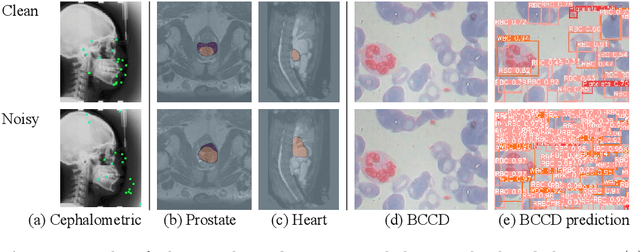
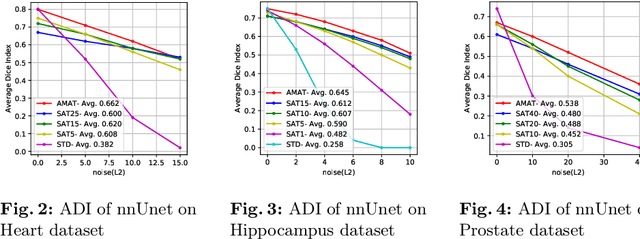
Abstract:Recent methods based on Deep Neural Networks (DNNs) have reached high accuracy for medical image analysis, including the three basic tasks: segmentation, landmark detection, and object detection. It is known that DNNs are vulnerable to adversarial attacks, and the adversarial robustness of DNNs could be improved by adding adversarial noises to training data (i.e., adversarial training). In this study, we show that the standard adversarial training (SAT) method has a severe issue that limits its practical use: it generates a fixed level of noise for DNN training, and it is difficult for the user to choose an appropriate noise level, because a high noise level may lead to a large reduction in model performance, and a low noise level may have little effect. To resolve this issue, we have designed a novel adaptive-margin adversarial training (AMAT) method that generates adaptive adversarial noises for DNN training, which are dynamically tailored for each individual training sample. We have applied our AMAT method to state-of-the-art DNNs for the three basic tasks, using five publicly available datasets. The experimental results demonstrate that our AMAT method outperforms the SAT method in adversarial robustness on noisy data and prediction accuracy on clean data. Please contact the author for the source code.
A Regularization Method to Improve Adversarial Robustness of Neural Networks for ECG Signal Classification
Oct 19, 2021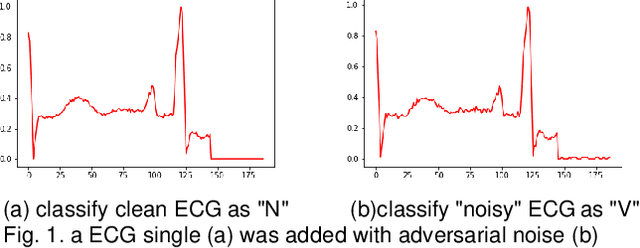
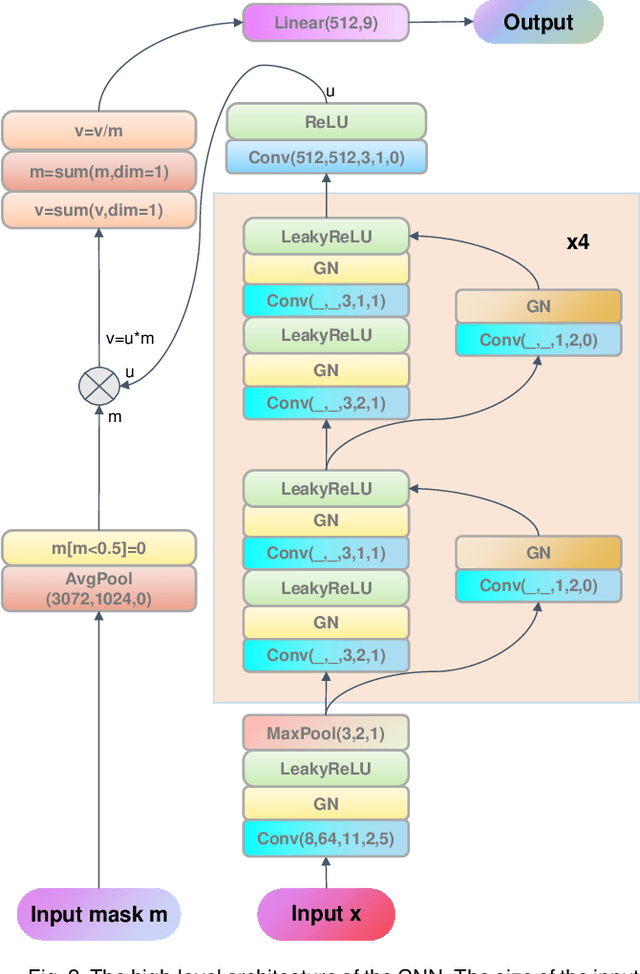
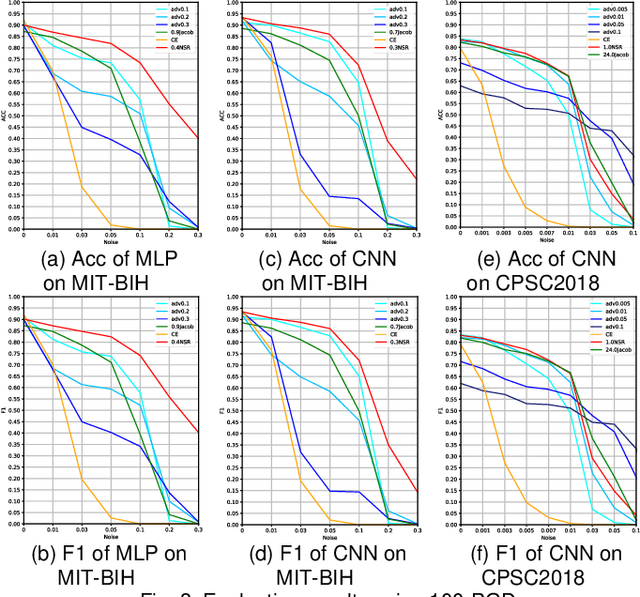
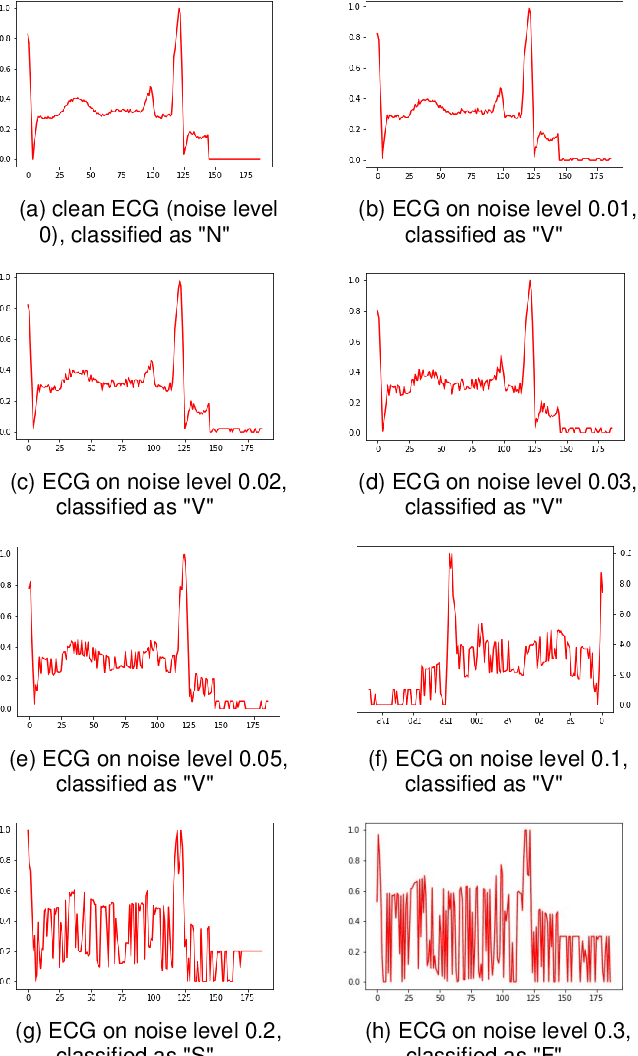
Abstract:Electrocardiogram (ECG) is the most widely used diagnostic tool to monitor the condition of the human heart. By using deep neural networks (DNNs), interpretation of ECG signals can be fully automated for the identification of potential abnormalities in a patient's heart in a fraction of a second. Studies have shown that given a sufficiently large amount of training data, DNN accuracy for ECG classification could reach human-expert cardiologist level. However, despite of the excellent performance in classification accuracy, DNNs are highly vulnerable to adversarial noises that are subtle changes in the input of a DNN and may lead to a wrong class-label prediction. It is challenging and essential to improve robustness of DNNs against adversarial noises, which are a threat to life-critical applications. In this work, we proposed a regularization method to improve DNN robustness from the perspective of noise-to-signal ratio (NSR) for the application of ECG signal classification. We evaluated our method on PhysioNet MIT-BIH dataset and CPSC2018 ECG dataset, and the results show that our method can substantially enhance DNN robustness against adversarial noises generated from adversarial attacks, with a minimal change in accuracy on clean data.
An Algorithm to Attack Neural Network Encoder-based Out-Of-Distribution Sample Detector
Oct 08, 2020



Abstract:Deep neural network (DNN), especially convolutional neural network, has achieved superior performance on image classification tasks. However, such performance is only guaranteed if the input to a trained model is similar to the training samples, i.e., the input follows the probability distribution of the training set. Out-Of-Distribution (OOD) samples do not follow the distribution of training set, and therefore the predicted class labels on OOD samples become meaningless. Classification-based methods have been proposed for OOD detection; however, in this study we show that this type of method is theoretically ineffective and practically breakable because of dimensionality reduction in the model. We also show that Glow likelihood-based OOD detection is ineffective as well. Our analysis is demonstrated on five open datasets, including a COVID-19 CT dataset. At last, we present a simple theoretical solution with guaranteed performance for OOD detection.
Enhance CNN Robustness Against Noises for Classification of 12-Lead ECG with Variable Length
Aug 08, 2020



Abstract:Electrocardiogram (ECG) is the most widely used diagnostic tool to monitor the condition of the cardiovascular system. Deep neural networks (DNNs), have been developed in many research labs for automatic interpretation of ECG signals to identify potential abnormalities in patient hearts. Studies have shown that given a sufficiently large amount of data, the classification accuracy of DNNs could reach human-expert cardiologist level. However, despite of the excellent performance in classification accuracy, it has been shown that DNNs are highly vulnerable to adversarial noises which are subtle changes in input of a DNN and lead to a wrong class-label prediction with a high confidence. Thus, it is challenging and essential to improve robustness of DNNs against adversarial noises for ECG signal classification, a life-critical application. In this work, we designed a CNN for classification of 12-lead ECG signals with variable length, and we applied three defense methods to improve robustness of this CNN for this classification task. The ECG data in this study is very challenging because the sample size is limited, and the length of each ECG recording varies in a large range. The evaluation results show that our customized CNN reached satisfying F1 score and average accuracy, comparable to the top-6 entries in the CPSC2018 ECG classification challenge, and the defense methods enhanced robustness of our CNN against adversarial noises and white noises, with a minimal reduction in accuracy on clean data.
Increasing-Margin Adversarial (IMA) Training to Improve Adversarial Robustness of Neural Networks
May 19, 2020



Abstract:Convolutional neural network (CNN) has surpassed traditional methods for med-ical image classification. However, CNN is vulnerable to adversarial attacks which may lead to disastrous consequences in medical applications. Although adversarial noises are usually generated by attack algorithms, white-noise-induced adversarial samples can exist, and therefore the threats are real. In this study, we propose a novel training method, named IMA, to improve the robust-ness of CNN against adversarial noises. During training, the IMA method in-creases the margins of training samples in the input space, i.e., moving CNN de-cision boundaries far away from the training samples to improve robustness. The IMA method is evaluated on four publicly available datasets under strong 100-PGD white-box adversarial attacks, and the results show that the proposed meth-od significantly improved CNN classification accuracy on noisy data while keep-ing a relatively high accuracy on clean data. We hope our approach may facilitate the development of robust applications in medical field.
Improve robustness of DNN for ECG signal classification:a noise-to-signal ratio perspective
May 18, 2020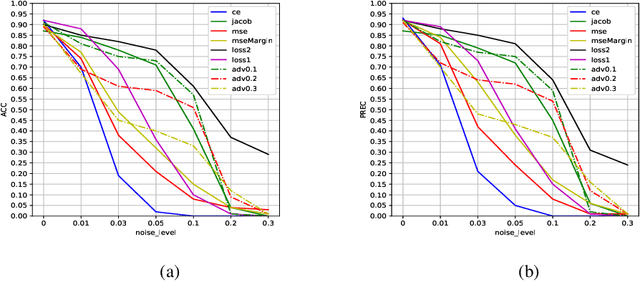
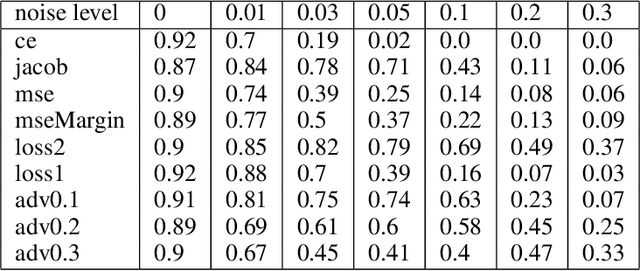
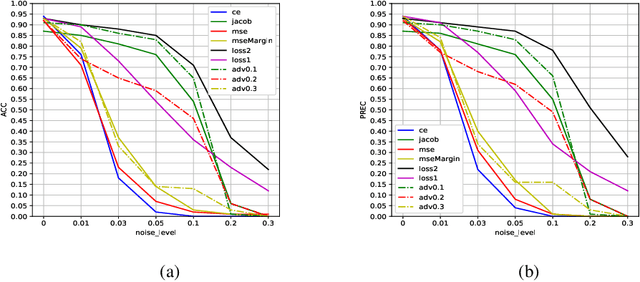
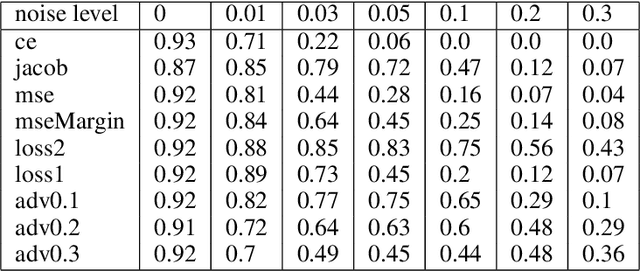
Abstract:Electrocardiogram (ECG) is the most widely used diagnostic tool to monitor the condition of the cardiovascular system. Deep neural networks (DNNs), have been developed in many research labs for automatic interpretation of ECG signals to identify potential abnormalities in patient hearts. Studies have shown that given a sufficiently large amount of data, the classification accuracy of DNNs could reach human-expert cardiologist level. A DNN-based automated ECG diagnostic system would be an affordable solution for patients in developing countries where human-expert cardiologist are lacking. However, despite of the excellent performance in classification accuracy, it has been shown that DNNs are highly vulnerable to adversarial attacks: subtle changes in input of a DNN can lead to a wrong classification output with high confidence. Thus, it is challenging and essential to improve adversarial robustness of DNNs for ECG signal classification, a life-critical application. In this work, we proposed to improve DNN robustness from the perspective of noise-to-signal ratio (NSR) and developed two methods to minimize NSR during training process. We evaluated the proposed methods on PhysionNets MIT-BIH dataset, and the results show that our proposed methods lead to an enhancement in robustness against PGD adversarial attack and SPSA attack, with a minimal change in accuracy on clean data.
 Add to Chrome
Add to Chrome Add to Firefox
Add to Firefox Add to Edge
Add to Edge